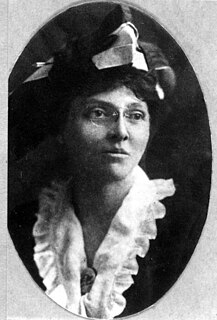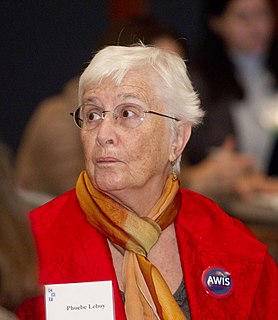Related Research Articles

Nettie Maria Stevens was an American geneticist who discovered sex chromosomes. In 1905, soon after the rediscovery of Mendel's paper on genetics in 1900, she observed that male mealworms produced two kinds of sperm, one with a large chromosome and one with a small chromosome. When the sperm with the large chromosome fertilized eggs, they produced female offspring, and when the sperm with the small chromosome fertilized eggs, they produced male offspring. The pair of sex chromosomes that she studied later became known as the X and Y chromosomes.

Helen Herron Taft Manning was an American professor of history and college dean. She was the middle child and only daughter of U.S. President William Howard Taft and his wife Helen Herron.
Alice Middleton Boring was an American biologist, zoologist, and herpetologist, who taught biology and did research in the United States and China.

Anna Johnson Pell Wheeler was an American mathematician. She is best known for early work on linear algebra in infinite dimensions, which has later become a part of functional analysis.
Maria Luisa (Weecha) Crawford is an American geologist/petrologist. She was born on July 18, 1939, in Beverly, Massachusetts. In 1960, Crawford received a bachelor of arts degree in geology from Bryn Mawr College, located in Pennsylvania. 5 years later, she received her doctorate degree from the University of California at Berkeley, where she met her husband, William Crawford. Shortly after graduating, Crawford became employed by Bryn Mawr College in the department of geology. Throughout her career, she had a wide range of interests. She was known to be one of the first scientists to use the electron micro probe on metamorphic rocks. Crawford has also been interested in lunar petrology and geochemistry. In this field, she researched the crystallization of lava that seemed to fill craters on the moon.
Marie Gertrude Rand Ferree was an American research scientist who is known for her extensive body of work about color perception. Her work included "mapping the retina for its perceptional abilities", "developing new instruments and lamps for ophthalmologists", and "detection and measurement of color blindness". Rand, with LeGrand H. Hardy and M. Catherine Rittler, developed the HRR pseudoisochromatic color test.
Rhonda Jo Hughes is an American mathematician, the Helen Herrmann Professor Emeritus of Mathematics at Bryn Mawr College.

Eleanora Frances Bliss Knopf was an American geologist who worked for the United States Geological Survey (USGS) and did research in the Appalachians during the first two decades of the twentieth century. She studied at Bryn Mawr College, and earned a bachelor's degree in chemistry, a master's degree in geology, and a Ph.D. in geology in 1912. She was the first American geologist to use the new technique of petrography which she pioneered in her life's work - the study of Stissing Mountain.
Eleanor Bontecou was an American lawyer, civil rights advocate, law professor and government official. Bontecou served as an attorney and investigator for both the U.S. Department of Justice and U.S. War Department. She also worked as a professor at two universities. During her career, Bontecou achieved national fame for her work in the civil liberties and women's rights movements.

Mary Hamilton Swindler was an American archaeologist, classical art scholar, author, and professor of classical archaeology, most notably at Bryn Mawr College, the University of Pennsylvania, and the University of Michigan. Swindler also founded the Ella Riegel Memorial Museum at Bryn Mawr College. She participated in various archaeological excavations in Greece, Egypt, and Turkey. The recipient of several awards and honors for her research, Swindler's seminal work was Ancient Painting, from the Earliest Times to the Period of Christian Art (1929).
Sally Peris Hughes-Schrader (1895–1984) was a professor of zoology at Duke University, 1962-1966.

Phoebe Starfield Leboy was an American biochemist and advocate for women in science.

Esther Fussell Byrnes (1867–1946) was an American biologist and science teacher. She was one of the first women copepodologists—scientists who study copepods. She was a fellow of the New York Academy of Sciences, as well as the American Society of Naturalists.

Marie Litzinger was an American mathematician known for her research in number theory, homogeneous polynomials, and modular arithmetic.
Cora Jipson Beckwith was an American zoologist who was a researcher and professor at Vassar College in New York.

Margaret Shove Morriss was an American academic historian, She was the Dean of Women in charge of Pembroke College in Brown University from 1923 to 1950.
Muborak Umarovna Mansurova was a Tajikistani biologist.

Agnes Low Rogers was a Scottish educator and educational psychologist.

Adelia Antoinette Field Johnston was an American educator and college administrator. She was the first female faculty member at Oberlin College, where she taught history, and the school's Dean of Women from 1870 to 1900.

Orlie Pell was an American pacifist, philosopher, and activist.
References
- 1 2 3 4 Commire, Klezmer, A., D. (2007). Dictionary of Women Worldwide: 25,000 Women Through the Ages. Detroit: Yorkin Publications. p. 887. ISBN 9780787676766.
- 1 2 3 4 5 6 7 8 9 10 11 12 Oakes, Elizabeth (2007). Encyclopedia of World Scientists. Detroit: Yorkin Publications. p. 872. ISBN 978-1438118826.
- 1 2 3 4 5 Wayne, Tiffany (2011). American Women of Since 1900. Santa Barbara: ABC-CLIO. pp. 508–509. ISBN 978-1598841589.